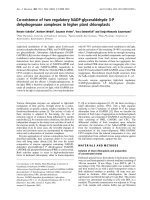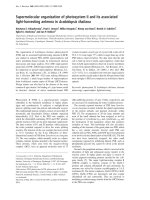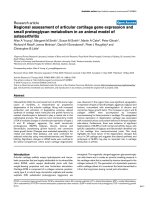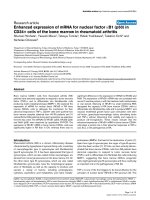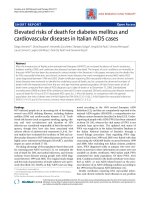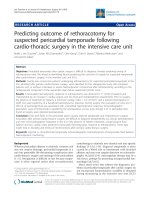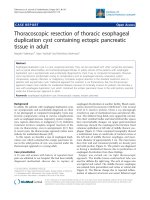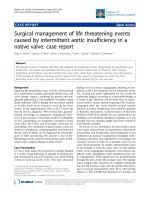Báo cáo y học: "Predicting outcome of rethoracotomy for suspected pericardial tamponade following cardio-thoracic surgery in the intensive care unit" ppt
Bạn đang xem bản rút gọn của tài liệu. Xem và tải ngay bản đầy đủ của tài liệu tại đây (433.18 KB, 7 trang )
RESEARCH ARTICLE Open Access
Predicting outcome of rethoracotomy for
suspected pericardial tamponade following
cardio-thoracic surgery in the intensive care unit
Birkitt L ten Tusscher
1
, Johan AB Groeneveld
1*
, Otto Kamp
2
, Evert K Jansen
3
, Albertus Beishuizen
1
and
Armand RJ Girbes
1
Abstract
Objectives: Pericardial tamponade after cardiac surgery is difficult to diagnose, thereby rendering timing of
rethoracotomy hard. We aimed at identifying factors predicting the outcome of surgery for suspected tamponade
after cardio-thoracic surgery, in the intensive care unit (ICU).
Methods: Twenty-one consecutive patients undergoing rethoracotomy for suspected pericardial tamponade in the
ICU, admitted after primary cardio-thoracic surgery, were identified for this retrospective study. We compared
patients with or without a decrease in severe haemodynamic compromise after rethoracotomy, according to the
cardiovascular component of the sequential organ failure assessment (SOFA) score.
Results: A favourable haemodynamic response to rethoracotomy was observed in 11 (52%) of patients and
characterized by an increase in cardiac output, and less fluid and norepinephrine requirements. Prior to surgery,
the absence of treatment by heparin, a minimum cardiac index < 1.0 L/min/m
2
and a positive fluid balance (>
4,683 mL) were predictive of a beneficial haemodynamic response. During surgery, the evacuation of clots and >
500 mL of pericardial fluid was associated wi th a beneficial haemodynamic response. Echocardiographic
parameters were of limited help in predicting the postoperative course, even though 9 of 13 pericardial clots
found at surgery were detected preoperatively.
Conclusion: Clots and fluids in the pericardial space causing regional tamponade and responding to surgical
evacuation after primary cardio-thoracic surgery, are difficult to diagnose preoperatively, by clinical, haemodynamic
and even echocardiographic evaluation in the ICU. Only absence of heparin treatment, a large positive fluid
balance and low cardiac index predicted a favourable haemodynamic response to rethoracotomy. These data
might help in deciding and timing of reinterventions after primary cardio-thoracic surgery.
Keywords: regional vs circumferential tamponade echocardiography, haemodynamics of tamponade, fluid balance,
haemodynamic monitoring
Background
Whereas pericardial effusion is relatively common and
may not require drainage, pericardial tamponade is a
rare but potentially life-threatening complication after
cardio-thoracic surgery and opening of the pericardium
[1-11]. Recognition is difficult or late because tampo-
nade is often regional rather than circumferential,
contributing to relatively non-classical and non-specific
findings [3-5,9,11-14]. Regional tamponade is often
caused by a blood clot or haematoma with localised
effusion and may even surpass detection on echocardio-
graphy [4,5,8,9,13,14]. Anticoagulant therapy may be a
risk factor, perha ps by promoting intrapericardial hae-
morrhage [2,6,7,9,15].
Many small series that address the diagnostic pro-
blems of pericardial tamponade after cardiac surgery do
not incorporate haemodynamic variables as obtained
during monitoring in the intensive care unit (ICU)
* Correspondence:
1
Department of Intensive Care, VU University Medical Center, De Boelelaan
1117, 1081 HV Amsterdam, The Netherlands
Full list of author information is available at the end of the article
ten Tusscher et al. Journal of Cardiothoracic Surgery 2011, 6:79
/>© 2011 ten Tusscher et al; lic ensee BioMed Central Ltd. This is an Open Access article distributed under the terms of the Creative
Commons Attribution License (http://creativeco mmons.org/licenses/by/2.0), which permits u nrestricted use, distribution, and
reproduction in any medium, pro vided the original work is properly cite d.
[5 -9,11,13]. The latter may facilitate detection of haemo-
dynamic compromise, but data may be confounded by
cardiac function , concomitant mechanical ventilation
and vasopressor/inotrop ic therapy. Many patients in
whom pericardial tamponade is suspected are, even if
delayed, ultimately subjected to rethoracotomy and
the haemodynamic response to this treatment can be con-
sidered as the reference for a correct diagnosis. The pre-
dictors, if any, of a favourable response to rethoracotomy
are largely unknown and could possibly help to decide on
timing for repeated surgery in patients suspected of peri-
cardial (regional) tamponade after primary cardiac surgery.
Theaimofthecurrentstudywasthereforetoevalu-
ate, retrospectively, the clinical, haemodynamic and
echocardiographic features that may predict a favourable
haemodynamic response to rethoracotomy for suspected
pericardial tamponade after recent cardio-thoracic sur-
gery, in a consecutive series of patients in the ICU.
Patients and methods
Patients
We included only patients who were in the ICU at the
time of diagnosing suspected pericardial tamponade
necessitating rethoracotomy, after having undergone pri-
mary cardio-thoracic surgery (at maximum 3 weeks ear-
lier), in the period from November 2003 through May
2009 at our institution. In th is period 3743 patients
underwent cardiac surgery, 259 patients underwent a
rethoracotomy (6.9%), mainly for chest tube bleeding.
Patients were selected from a regi stry of cardiac surgery
patients, surgical and ICU records. These electronic
databases were screened for rethoracotomy and tampo-
nade, individual case were reviewed for inclusion. Exclu-
sion criteria were rethoracotomy for postoperative
bleeding alone, after other than cardio-thoracic surgery.
Data collection
The selection of collected data was based on previously
suggested risk factors, clinical signs and echocardio-
graphic features of pericardial tamponade after primary
cardiac or aortic root surgery [2]. Electronic patient
charts were reviewed to obtain age, sex, weight, Euro-
score, previous history of chronic renal insufficiency and
use of heparin, acetylsalicylic acid and clopidrogel. The
type of primary surgery was retrieved. The chart of the
rethoracotomy was evaluated for evacuation of clots and
pericardial fluid. In 19 patients echocardiography (Phi-
lips Sonos 7500, Philips IE33 and GE Vivid 7) was per-
formed prior to rethoracotomy, and 17 were made
transoesophageally and reporting was restricted to the
latter. Of these, 14 were available for lat er reasse ssment
(OK), after blinding to study results. We evaluated the
presence of the following features of cardiac tamponade:
right atrial collapse, right ventricular collapse, left atrial
collapse, left ventricular collapse, increased respiratory
variation of mitral blood flow velocities, pericardial effu-
sions, magnitude and location, and identifiable clots
[1,4-6,8,11-14]. We used electronic patient charts for
collection of haemodynamic parameters including, for
worst values within 24 h prior to rethoracotomy, worst
value within and at 24 h after rethoracotomy, and for
those directly prior to and after rethoracotomy of, heart
rate and rhythm, mean arterial pressure (MAP), pul-
monary artery occlusion pr essure (PAOP), central
venous pressure (CVP), cardiac index (CI), mixed or
central venous O
2
saturation (S
v
O
2
), diuresis (mL/h)
and fluid balance (mL) per 24 h. We also collected
doses (in mg/h per infusion pump) of vasopressor/ino-
tropes used for treatment and selected laboratory para-
meters such as coagulation times, platelet counts and
serum creatinine values, that are assessed daily on rou-
tine basis in our unit. We calculated the cardiovascular
(CV) component of the Sequential Organ Failure
Ass essment (SOFA) score, within 24 h before and at 24
h after rethoracotomy, to judge haemodynamic compro-
mise and its improvement upon reintervention. The
SOFA score evaluates organ function over time [16] and
we assessed the CV component of the score considering
this most relevant for our study goal. The CV compo-
nent of the SOFA score takes MAP and the doses per
kg of vasopressor/inotropic therapy used in the treat-
ment of hypotension into account, and ranges from 0 to
4 with 0 indicating normo-tension without treatment.
We thus separated patients with and without a decrease
of CV SOFA score > 1 within 24 h after rethoracotomy
and studied possible predictors of this favourable hae-
modynamic response to surgery.
Patients otherwise received protocolized standard care
in our unit, with pressure-controlled mechanical ventila-
tion and positive end-expiratory pressure (PEEP) and
inspiratory O
2
fraction (FIO
2
) dosed on the basis of
arterial PO
2
. Respiratory rate was adjusted to maintain
normocarbia while tidal volume was aimed not to
exceed 8 mL/kg, recruitment procedures were per-
formed routinely. Haemodynamic monitoring was routi-
nely done with help of a catheter in the radial artery
and either a central venous catheter and/or a pulmonary
artery catheter (n = 14). The latter allowed to measure
the PAOP after proper wedging, the cardiac output and
the mixed venous S
v
O
2
(Radiometer, Copenhagen, Den-
mark). Pressures were measured at the end of expiration
after calibration and zeroing to atmospheric pressure,
with patients in supine position. For cardiac output
measurements, the bolus thermodilution method was
used with help of central venous, room-temperature
D5W injections. Triplicate measurements, routinely
done after major clinical or therapeutic changes and
otherwise once per shift, were av eraged (Maquette,
ten Tusscher et al. Journal of Cardiothoracic Surgery 2011, 6:79
/>Page 2 of 7
Milwaukee, Wisc., USA) and normalized to body surface
area calculated from height and weight. Attending phy-
sicians gave fluids and vasopressor/inotropic treatments
on the basis of severity of haemodynamic compromise
and expected haemodynamic responses to such treat-
ments, while awaiting results of diagnostic measures and
surgical interventions. For vasopressor therapy, norepi-
nephrine is the drug of first choice in our institution.
Mortality refers to death in the hospital.
Statistical analysis
Data are summarized by median (range) and non-para-
metric tests were used to compare groups according to
the course of CV SOFA after rethoracotomy, including
the Wilcoxon signed rank test for paired and the Mann-
Whitney U test for unpaired data, because of the small
numbers, even though most data were normally distrib-
uted (Kolmogorov-Smirnov test P > 0.05). Fisher’sexact
test was used to compare proportions. Receiver operat-
ing characteristic (ROC) curve analysis of sensitivity ver-
sus 1-specificity was done for variables different between
outcome groups at the P < 0.10 level, yielding an area
under the curve (AUC) and cut-off value with highest
specificity and sensitivity, to evaluate predictive values of
variables for a fall in CV SOFA after rethoracotomy.
The statistic was used to evaluate reproducibility of
the echocardiograms, with respect to number of visible
features of potential tamponade. Exact P va lues are
given and considered statistically significant if < 0.05.
Results
Clinical features
We identified 21 consecutive patients in the ICU in
whom a rethoracotomy was performed because of sus-
pected pericardial tamponade, 1 to 16 (median 3) days
after primary cardio-thoracic surgery (Table 1). There
were 2 patients with a previous rethoracotomy because
of surgical bleeding between primary surgery and
rethoracotomy for suspected tamponade. Two patients
started renal replacement therapy befo re rethoracotomy
for suspected tamponade, one patient was already on
renal replacement therapy for chronic renal insufficiency
prior to the first surgery. Eight patients had received
heparin in therapeutic doses between primary surgery
and rethoracotomy. All patients were on mechanical
ventilation, whereas one patient had experienced a car-
diac arrest prior to rethoracotomy. Mortality in hospit al
was 3 (30%) in patients with unchanged and 3 (27 %) in
patients with decreasing CV SOFA score upon rethora-
cotomy, respectively (P = 1.0).
Haemodynamic parameters
In the 24 h preceding rethoracotomy for suspected peri-
cardial tamponade, 71% of patients had a period of
hypotension (MAP < 60 mm Hg), 80% percent an ele-
vated central venous pressure (> 12 mm Hg), 33% (an
episode of) atrial fibrillation and 67% tachycardia (heart
rate > 100/min). Minimum urine output was low in
patients with and without a decrease in CV SOFA score
at 24 h after rethoracotomy (median of 7 and 0 mL/h
respectively). Table 2 summarizes haemodynamic and
laboratory variables in this period. There was no major
diff erence in the severity of haemodynamic compromise
between patients in both groups. The PAOP-CVP gradi-
ent did not differ either.
Echocardiographic parameters prior to rethoracotomy
Echocardiography was performed on indication. In two
patients echocardiography was not performed prior to
rethoracotomy, because of hemodynamical instability
and high clinical suspicion of tamponade these patients
went straight to the operating room. In the remaining
19 patients echocardiography was performed, 17 were
made transoesophageally. In the two patients with
only transthoracic echocardiography, one examination
showedaclotnexttotherightventriclewithoutcom-
pression and no other abnormalities, while the other
echo showed a clot behind the left atrium with
Table 1 Patient characteristics.
Age,
year
Sex, m/f Weight, kg EuroScore Type of primary
surgery
61 m 69 6 AVRbio
84 f 75 13 Arch
64 m 100 7 CABG, MVP
74 m 82 8 CABG, AVRbio
61* f 115 7 AVR, MVP
76 m 61 6 CABG, AVRbio
65 m 89 17 AVRbio
59 f 102 6 AVR, MVR
75 f 84 7 CABG, AVR
78 m 70 6 Arch
65 m 79 2 CABG
75 f 63 6 CABG
76 f 85 10 Arch+ascending
83 m 82 7 CABG
68 m 65 5 CABG
71 f 68 8 CABG
74 f 57 8 CABG
71 m 90 6 AVRbio
68 f 65 10 CABG, Bentall
85 m 66 16 CABG
67 f 92 17 MVR
Abbreviations: AVRbio = aortic valve replacement by biological valve, Arch =
aortic arch replacement, CABG = coronary artery bypass grafting, MVP =
mitral valve plasty, AVR = aortic valve replacement, Arch + ascending = aortic
arch and ascending a orta replacement, MVR = mitral valve replacement,
Bentall = aortic valve and arch replacement; *dependent on intermittent
haemodialysis.
ten Tusscher et al. Journal of Cardiothoracic Surgery 2011, 6:79
/>Page 3 of 7
compression but without collapse of the left atrium
together with 1 cm of pericardial effusion.
All but one patients who underwent transoesophageal
echocardiography prior to rethoracotomy (n = 17) had a
pericardial effusion, which was circumferential in 2
patientsonly.Only36%hadatleastone(range0-3)
echographic sign of possible pericardial tamponade on
transoesophageal echocardiography, and none pred icted
the outcome of rethoracotomy (Table 3). Of 13 clots
found on rethoracotomy, 9 (69%) had been identified
prior to surgery in patients undergoing transoesophageal
echocardiography, whereas there were 2 correct negative,
2 false positive and 4 false negative echocardiographic
diagnoses. Twelve visible clots on echocardiography were
located anterior to the right atrium, ventricle, or both,
while 2 were located posterior. At later reassessment of
the preoperative echocardiograms, the number of features
per patient suggestive for tampona de was 0-2, with 43%
showing at least one feature. In the reassessments, 11 of
the 11 clots found at surgery were detected, with 3 false
positives. The statistic between number of echocardio-
graphic features suspected for tamponade at first and sec-
ond assessment was 0.23 (P = 0.21).
Response to rethoracotomy
Only 52% of patients haemodynamically improved after
rethoracotomy as judged from a decrease in CV SOFA
score at 24 h after surgery (Table 4). Patients with a fall
in CV SOFA at 24 h after rethoracotomy had an increase
in minimum CI, less fluid and norepinephrine require-
ments on the day after surgery as compared to preopera-
tively, than patients without such fall in CV SOFA.
Predictors of response prior to and during rethoracotomy
Patients having had heparin between primary surgery
and rethoracotomy tended to have less clots (P = 0.09)
and had less haemodynamic improvement (P = 0.024)
upon rethoracotomy for suspected tamponade. In a
ROC curve, a positive fluid balance in the 24 h prio r to
surgery of 4 ,683 mL o r more had 100% specificity and
45% sensitivity for a fall in CV SOFA upon rethoracot-
omy with an AUC of 0.78 (P = 0.025). A minimum CI <
1.0 L/min/m
2
in the 24 h prior to surgery had 50% sen-
sitivity and 100% specificity for a fall in CV SOFA after
rethoracotomy (AUC ROC 0.78, P = 0.023).
Table 2 Haemodynamic and laboratory values within 24 h prior to rethoracotomy for suspected pericardial
tamponade as predictors of its haemodynamic benefit.
CV SOFA unchanged n = 10 CV SOFA decreased n = 11 P
Haemodynamics
Maximum heart rate (b/min) 121 (76-200) 107 (90-193) 0.65
Minimum MAP (mmHg) 55 (5-64) 53 (46-67) 0.47
Minimum CI (L/min/m2) 2.1 (1.7-3.0) 1.4 (1.0-2.6) 0.09
Maximum PAOP (mmHg) 23 (15-33) 18 (11-26) 0.28
Maximum CVP (mmHg) 19 (0-30) 19 (7-27) 1.00
Minimum SvO2 (%) 40 (33-62) 53 (46-67) 0.15
Maximum norepinephrine, mg/h 4.0 (0-8) 1.2 (0-6) 0.17
Maximum dopamine, mg/h 0 (0-80) 0 (0-20) 0.92
CV SOFA 4 (3-4) 4 (2-4) 0.51
Minimum diuresis (mL/h) 0 (0-40) 7 (0-47) 0.43
Fluid balance (mL/24 h) 3,355 (1,184-4,863) 4,828 (2,988-11,205) 0.07
Laboratory
PT, INR 1.6 (1.2-1.8) 1.6 (1.3-4.8) 0.56
aPTT, sec 52 (34-38) 41 (35-69) 0.28
Platelets, ×10
9
/L 151 (58-228) 106 (31-161) 0.28
Creatinine, micromol/L 165 (87-407) 121 (77-310) 0.15
Median (range) or number (percentage), where appropriate; CV SOFA = cardiovascular sequential organ failure assessment score, MAP = mean arterial pressure,
CI = cardiac index, PAOP = pulmonary artery occlusion pressure, CVP = central venous pressure, S
v
O
2
= mixed or central venous O
2
saturation, PT = prothrombin
time, aPTT = activated partial thromboplastin time.
Table 3 Echocardiographic findings prior to
rethoracotomy for suspected pericardial tamponade.
CV SOFA
unchanged n = 9
CV SOFA
decreased n = 8
P
Pericardial effusion (cm) 2.0 (1.0-4.0) 2.0 (0-4.0) 0.91
Clot 6 (67) 5 (63) 1.0
Right atrial collapse 4 (44) 1 (13) 0.29
Left atrial collapse 0 2 (25) 0.21
Right ventricular collapse 1 (11) 0 1.0
Flow variations 4 (44) 0 0.08
Low end-systolic left
ventricular volume
4 (67) 4 (50) 0.63
Median (range) or number (percentage), where appropriate. CV SOFA =
cardiovascular sequential organ failure assessment score.
ten Tusscher et al. Journal of Cardiothoracic Surgery 2011, 6:79
/>Page 4 of 7
All patients had clots identified in the pericardial
space at rethoracotomy when responding to surgery
whereas only 6 of 10 non-responding patients had such
clots (P = 0.035). Hence, the specificity of the presence
of clots for postoperative haemodynamic improvement
was 100% and sensitivity 65%. The volume of pericardial
fluid recovered at rethoracotomy (in n = 9 patients)
amounted to 500 (350-1000) mL in patients with
unchanged CV SOFA and 800 (600-1700) in patients
with a decrease in CV SOFA after rethoracotomy (P =
0.09). The AUC for the ROC curve for improvement
upon rethoracotomy of > 500 mL of pericardial fluid
removed was 0.89 (P = 0.005), with a specificity of 83%
and a sensitivity of 100%.
Discussion
Our study suggests that clinical, haemodynamic and
even echocardiographic f eatures are relatively poor pre-
dictors of pericardial tamponade responding to surgical
reintervention in ICU patients after primary cardio-thor-
acic surgery. The data may nevertheless help guiding
decisions for rethoracotomy.
Pericardial tamponade has been suggested to occur
after cardiac surgery in an early and late form, having
different etiologies, with regional obstruction more
common in the former and circumferential effusion
more frequently encountered in the latter [1-9,11,14].
Regional tamponade can be caused by a blood clot or
haemato ma with localiz ed effusion and often lacks clas-
sicalsymptomsandsignsaswellasechocardiographic
features [4,5,8,9,13,14]. Tamponade caused by circum-
ferential effusion or regional obstruction is difficult to
separate and, in this study, we therefore included all
patients who underwent rethoracotomy for suspected
tamponade after cardio-thoracic surgery within three
weeksaftersurgeryandwhowerestillintheintensive
care unit (ICU), in order to study predictors of success
of rethoracotomy [9]. The amount of pericardial fluid
recovered at rethoracotomy was in the same range as
found in other post cardio-thoracic tamponade studies
and the median duration to rethoracotomy of 3 days
was also comparable [4-6,8,9]. Many small series that
address the diagnostic problems of pericardial tampo-
nade after cardiac surgery do not incorpor ate haemody-
namic variables as obtained during monitoring in t he
intensive care unit (ICU) [5,6,8,9,11,13].
When pericardial tamponade was suspected, 52% of
our patients had a improvement of the CV SOFA score,
with a rise in cardia c output and less norepineph rine
and fluid requirements in the first 24 hours after
Table 4 Haemodynamic variables at 24 h after rethoracotomy for suspected pericardial tamponade.
CV SOFA unchanged CV SOFA decreased P for groups
n = 10 P vs preop. n = 11 P vs preop.
Within 24 h
Max HR (b/min) 112 (83-143) 0.21 104 (76-116) 0.19 0.31
Min MAP (mmHg) 63 (40-67) 0.03 63 (49-76) 0.07 0.65
Min CI (L/min/m2) 1.9 (1.0-2.8) 0.61 2.2 (1.7-2.4) 0.07 0.73
Max PAOP (mmHg) 22 (14-27) 0.60 22 (12-33) 0.69 0.90
Max CVP (mmHg) 15 (9-23) 0.09 17 (7-22) 0.31 0.35
Min S
v
O
2
(%) 58 (47-74) 0.04 64 (51-75) 0.11 0.49
Max nor, (mg/h) 1.6 (0.2-3.6) 0.01 0.2(0-3.0) 0.005 0.02
Max dop (mg/h) 0 (0-24) 0.28 0 (0-16) 1.0 0.81
Min diuresis (mL/h) 6 (0-50) 1.0 20 (0-45) 0.51 0.31
Fluid balance (mL/24 h) 2,978(507-5,167) 0.77 2,159(-910-3,697) 0.003 0.085
At 24 h
HR (b/min) 96 (73-120) 91 (63-108) 0.92
MAP (mmHg) 77 (64-98) 86 (70-99) 0.15
CI (L/min/m
2
) 2.2 (1.9-3.2) 2.3 (1.9-3.7) 0.62
PAOP (mmHg) 16 (14-21) 16 (6-21) 0.62
CVD (mmHg) 12 (5-17) 13 (7-17) 0.35
S
v
O
2
(%) 70 (47-77) 65 (60-81) 0.95
Nor, (mg/h) 0.8 (0-2.0) 0 (0-1.8) 0.006
Dop (mg/h) 0 (0-8) 0 0.29
CV SOFA 4 (3-4) 0 (0-3) na
Median (range) or number (percentage), where appropriate; CV SOFA = cardiovascular sequential organ failure assessment score, preop. = preoperatively, max =
maximum, min = minimum, HR = heart rate, MAP = mean arterial pressure, CI = cardiac index, PAOP = pulmonary artery occlusion pressure, CVP = central
venous pressure, S
v
O
2
= mixed or central venous O
2
saturation, nor = norepinephrine, dop = dopamine, na = not applicable. The change in minimum CI (P =
0.024) and fluid balance from 24 h prior to and after rethoracotomy (P = 0.004) differed between groups.
ten Tusscher et al. Journal of Cardiothoracic Surgery 2011, 6:79
/>Page 5 of 7
reintervention. Only few variables predicted the post-
operative haemodynamic course, such as the amount of
fluids infused prior to rethoracotomy in attempts to
increase a low cardiac output. The value of cardiac fill-
ing pressures in this context was surprisingly low and
the absence of equilibration of pressures, for instance
may relate to the predominance of regional versus cir-
cumferential tamponade in our patients. Fluid therapy is
the primary therapeutic step in the medical treatment of
pericardial tamponade, but, depending on pericardial
pressure, only half of patients may respond by an
increase in cardiac output [15]. It can be surmised that
severe inflow limitation would preclude such effect.
Apparently, the presence of clots and fluids in the
pericardium exerting pressure and thereby obstructing
cardiac inflow, is hard to predict by clinical and haemo-
dynamic features.
We studied both echocardiographic features as well as
haemodynamic variables, since t he former may b e
regarded as superior for tamponade detection. However,
the value of echocardi ography in predicting a favourable
outcome to rethoracotomy was also disappointing in our
series. Only a minority (36%) of the patients with sus-
pected tamponade had at least one echographic sign of
possible pericardial tamponade on transoesophageal echo-
cardiography, and none predicted the outcome of rethor-
acotomy. Some clots and fluids found at surgery and
associated with haemodynamic improvement after eva-
cuation, were not detected preoperatively by echocardio-
graphy. The usefulness of echocardiography may depend
in part on the expertise of the examiner. Therefore, echo-
cardiograms were reassessed by a senior cardiologist
(OK). However, this reassessment of echocardiograms did
not improve its diagnostic value.
It is increasingly suggested that echocardiographic
abnormalities may not fully predict haemodynamic
sequelae and that, conversely, even small circumferential
effusions may compromise haemodynamics [3,5,7,11,13,
14]. Indeed, if abnormalities detected by echocardiogra-
phy are followed by pericardial evacuation and this does
not result in haemodynamic relief, the diagnostic value of
the technique can be doubted. Hence, the question
remains whether and when surgical reintervention is
necessary or not, in a critically ill patient with haemody-
namic compromise after prior cardio-thoracic surgery.
We intended to contribute to such decision making by
comparing haemodynamic and echocardiographic find-
ings in patients with or without a decrease in severe hae-
modynamic compromise, according to the cardiovascular
component of the sequential organ failure assessment
(SOFA) score, after rethoracotomy for suspected pericar-
dial tamponade.
Suggested risk factors for pericardial tamponade after
cardiac surgery diagnosed by more or less classical
clinical and echocardiographic features include primary
closure of the pericardium, anticoagulation, female gen-
der, valvular surgery and others [2,6,7,9,17]. Anticoagu-
lant therapy may be a risk factor, perhaps by promoting
intrapericardial haemorrhage [2,6,7,9,15]. In our stu dy,
prior heparinization seemed to protect rather than to
increase the ris k for pericardial tamponade, as suggested
previously. This may be caused, in part, by decreased
rather than increased clot formation with less obstruc-
tion, in the presence of adequate drainage [10].
The limit ations of this retrospective study include the
relatively low number of patients, selected on the basis
of strict inclusion criteria. In this study we aimed to
identify predictors for the effect of rethoracotomy in
patients with suspected tamponade. We may not have
inadvertedly excluded patients with suspected tampo-
nade not undergoing reintervention, since we do not
manage these patients conservatively. Conversely, we
cannot decide on the value o f rethoracotomies that are
not associated with clear haemodynamic improvement
in patients with severe haemodynamic compromise
after primary cardio-thoracic surgery. Indeed, reduction
of norepinephrine requirements in the gr oup without
decrease a in CV SOFA may partly relate to less severe
tamponade relieved by surgery. This does not invali-
date our conclusions, however. We also cannot specu-
late on the greater contribution of poor preoperative
cardiac function and further deterioration upon pri-
mary surgery, even though postoperative transmural
infarctions were not detected, in the group with
unchanged SOFA.
Conclusion
Clots and fluids in the pericardial space causing regional
tamponade and responding to surgical evacuation after
primary cardio-thoracic surgery, are difficult to diagnose
preoperatively, by clinical, haemodynamic a nd even
echocardiographic variables obtained in the ICU. Our
data suggest that in patients with severe haemodynamic
compromise in the ICU after primary cardio-thoracic
surgery, without heparin but having a marked positive
fluid balance and low CI, regional pericardial tamponade
by clots and fluids amenable to surgical decompression
should be considered.
List of abbreviations
ICU: intensive care unit; SOFA score: sequential organ failure assessment
score; CV: cardiovascular; MAP: mean arterial pressure; PAOP: pulmonary
artery occlusion pressure; CVP: central venous pressure; CI: cardi ac index;
PEEP: positive end expiratory pressure; S
v
O
2
: mixed or central venous O
2
saturation; ROC: receiver operating characteristics; AUC: area under the curve
Author details
1
Department of Intensive Care, VU University Medical Center, De Boelelaan
1117, 1081 HV Amsterdam, The Netherlands.
2
Department of Cardiology, VU
University Medical Center, De Boelelaan 1117, 1081 HV Amsterdam, The
ten Tusscher et al. Journal of Cardiothoracic Surgery 2011, 6:79
/>Page 6 of 7
Netherlands.
3
Department of Cardiothoracic surgery, VU University Medical
Center, De Boelelaan 1117, 1081 HV Amsterdam, The Netherlands.
Authors’ contributions
BLT and ABJG wrote most part of this manuscript. OK reassessed all
echocardiograms and gave some comments for this manuscript. AB, ARJG
and EKK gave some comments on this manuscript. All the authors read and
approved the final manuscript.
Competing interests
The authors declare that they have no competing interests.
Received: 22 October 2010 Accepted: 30 May 2011
Published: 30 May 2011
References
1. Weitzman LB, Tinker WP, Kronzon I, Cohen ML, Glassman E, Spencer FC:
The incidence and natural history of pericardial effusion after cardiac
surgery – an echocardiographic study. Circulation 1984, 69(3):506-511.
2. Ikäheimo MJ, Huikun KEJ, Korhonen UR, Linnaluoto MK, Tarkka MR,
Takkunen JT: Pericardial effusion after cardiac surgery: incidence, relation
to the type of surgery, antithrombotic therapy, and early coronary
bypass graft patency. Am Heart J 1988, 116:97-102.
3. D’Cruz IA, Dick A, Pai GM, Kamath MV: Large pericardial effusion after
cardiac surgery: role of echocardiography in diagnosis and
management. South Med J 1989, 82(3):287-291.
4. Russo AM, OConner WH, Waxman HL: Atypical presentations and
echocardiographic findings in patients with cardiac tamponade
occurring early and late after cardiac surgery. Chest 1993, 104:71-78.
5. Chuttani K, Tischler MD, Pandian NG, Lee RT, Mohanty PK: Diagnosis of
cardiac tamponade after cardiac surgery: relative value of clinical,
echocardiographic, and hemodynamic signs. Am Heart J 1994,
127:913-918.
6. Pepi M, Muratori M, Barbier P, Doria E, Arena V, Beti M, Celeste F, Guazzi M,
Tamborini G: Pericardial effusion after cardiac surgery: incidence, site,
size and haemodynamic consequences. Br Heart J 1994, 72:327-331.
7. Ball JB, Morrison WL: Experience with cardiac tamponade following open
heart surgery. Heart Vessels 1996, 11:39-43.
8. Bommer WJ, Follette D, Pollock M, Arena F, Bognar M, Berkoff H:
Tamponade in patients undergoing cardiac surgery: a clinical-
echocardiographic diagnosis. Am Heart J 1995, 130:1216-23.
9. Kuvin JT, Harati NA, Pandian NG, Bojar RM, Khabbaz KR: Postoperative
cardiac tamponade in the modern surgical era. Ann Thorac Surg 2002,
74(4):1148-1153.
10. Eryilmaz S, Emiroglu O, Eyileten Z, Akar R, Yazicioglu L, Tasoz R, Kaya B,
Uysalel A, Ucanok K, Corapcioglu T, Ozyurda U: Effect of posterior
pericardiac drainage on the incidence of pericardial effusion after
ascending aortic surgery. J Thorac Cardiovasc Surg 2006, 132:27-31.
11. Imren Y, Tasoglu I. Oktar GL, Benson A, Naseem T, Cheema F, Unal Y: The
importance of transesophageal echocardiography in diagnosis of
pericardial tamponade after cardiac surgery. J Card Surg 2008, 23:450-453.
12. Reichert CLA, Visser CA, Koolen JJ, van den Brink RBA, van Wezel HB,
Meyne NG, Dunning AJ: Transoesophageal echocardiography in
hypotensive patients after cardiac operations. J Thorac Cardiovasc Surg
1992, 104:321-326.
13. Beppu S, Tanaka N, Nakatani S, Ikegami K, Kumon K, Miyatake K: Pericardial
clot after open heart surgery: its specific localization and
haemodynamics. Eur Heart J 1993, 14:230-234.
14. Price S, Prout J, Jaggar SI, Gibson DG, Pepper JR:
Tamponade following
cardiac surgery: terminology and echocardiography may both mislead.
Eur J Cardiothorac Surg 2004, 26(6):1156-1160.
15. Malouf JF, Alam S, Gharzeddine W, Stefadouros MA: The role of antico-
agulation in the development of pericardial effusion and late
tamponade after cardiac surgery. Eur Heart J 1993, 14:1451-1457.
16. Ferreira FL, Bota DP, Bross A, Mlot C, Vincent JL: Serial evaluation of the
SOFA score to predict outcome in critically ill patients. JAMA 2001,
286:1754-1758.
17. Sagristà-Sauleda J, Angel J, Sambola A, Permanyer-Miralda G: Hemody-
namic effects of volume expansion in patients with cardiac tamponade.
Circulation 2008, 117:1545-1549.
doi:10.1186/1749-8090-6-79
Cite this article as: ten Tusscher et al.: Predicting outcome of
rethoracotomy for suspected pericardial tamponade following cardio-
thoracic surgery in the intensive care unit. Journal of Cardiothoracic
Surgery 2011 6:79.
Submit your next manuscript to BioMed Central
and take full advantage of:
• Convenient online submission
• Thorough peer review
• No space constraints or color figure charges
• Immediate publication on acceptance
• Inclusion in PubMed, CAS, Scopus and Google Scholar
• Research which is freely available for redistribution
Submit your manuscript at
www.biomedcentral.com/submit
ten Tusscher et al. Journal of Cardiothoracic Surgery 2011, 6:79
/>Page 7 of 7
